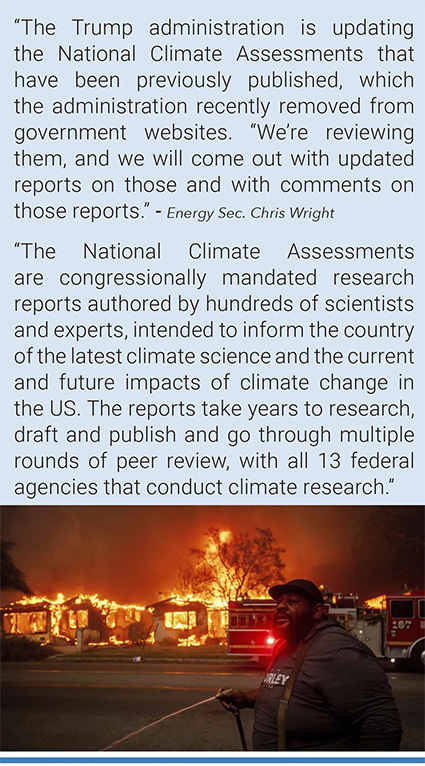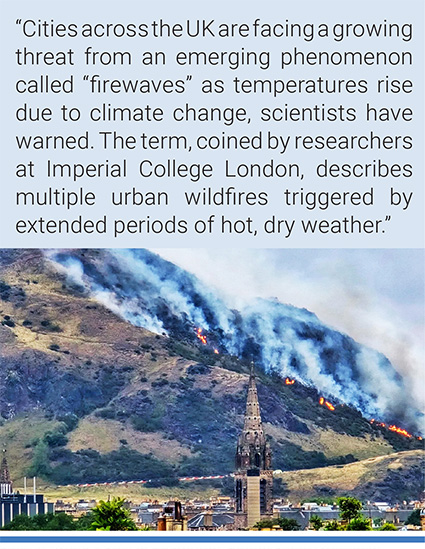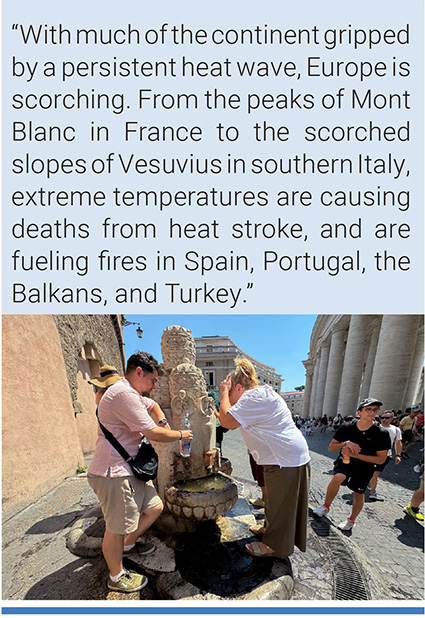Monthly Summaries
Issue 104, August 2025 | "Firewaves"
[DOI]
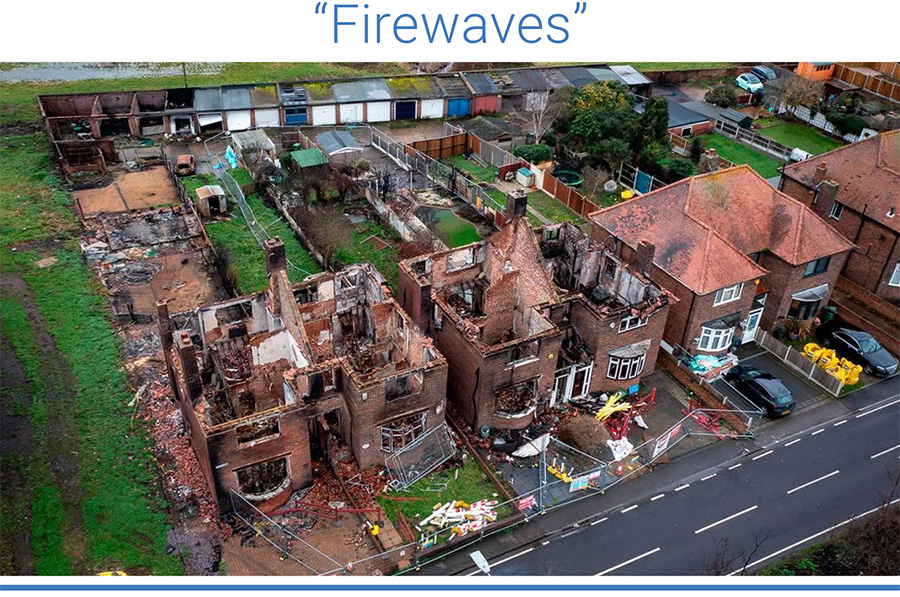
Houses destroyed by fires in Wennington in East London. Photo: Adam Gerrard/Daily Mirror.
August media coverage of climate change or global warming in newspapers around the globe diminished by 7% overall from July 2025. Coverage in August 2025 was also down 25% from August 2024 levels. Figure 1 shows trends in newspaper media coverage at the global scale – organized into seven geographical regions around the world – from January 2004 through August 2025. International wire services stories in August 2025 went down 5% from July 2025 as well as decreasing 4% from August 2024. Nonetheless, humans continue to contribute to disruptions through the burning of fossil fuels and patterns of land use. Carbon dioxide concentrations in the atmosphere – the greenhouse gas that contributes most to climate change – is 50% higher than it was at the dawn of the Industrial Revolution (and the highest in the last 14 million years). Meanwhile, 2024 remains the warmest year in nearly 150 years of recorded history while the last ten years have been the ten hottest years since record-keeping began. The quantity of media coverage is struggling to keep pace with the pace of change.
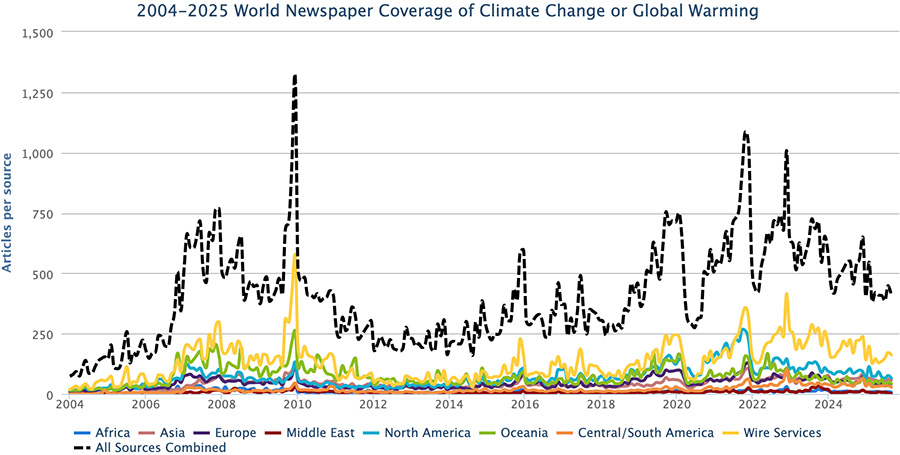
Figure 1. Newspaper media coverage of climate change or global warming in print sources in seven different regions around the world, from January 2004 through August 2025.
At the regional level, overall downward trends matched decreased levels of August 2025 coverage in all regions: the European Union (EU) (-2%), Asia (-6%), Oceania (-11%), Latin America (-15%), North America (-14%), Africa (-19%), and in the Middle East (-67%) compared to July 2025. In the United States (US), print media coverage dropped 17% from July 2025 and went down 21% from August 2024 (Figure 2). A drop off in US television coverage was even more pronounced, with a 36% decrease from July 2025 and a 50% drop from August 2024.
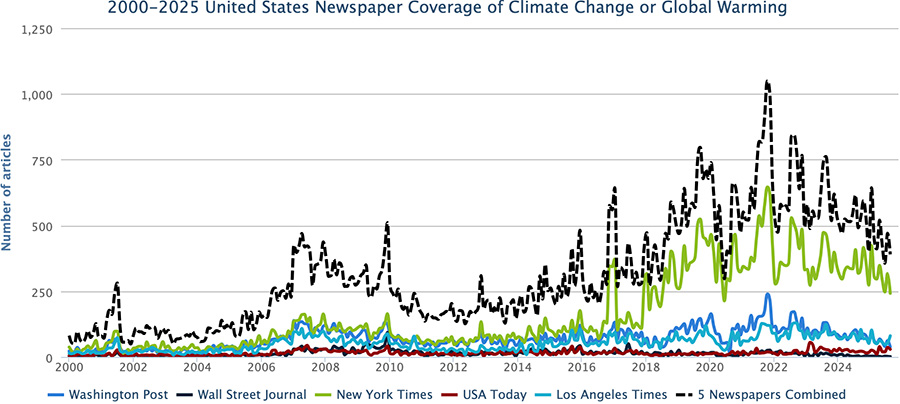
Figure 2. US newspaper coverage of climate change or global warming from January 2000 through August 2025.
Moving to the content of news coverage about climate change in August 2025, there were many political and economic-themed media stories about climate change or global warming were evident. For instance, El País journalist Naiara Galarraga Gortázar wrote about the difficulties in holding the climate summit in Belém, noting “With 90 days to go until COP30 in Belém, skyrocketing hotel prices and a shortage of beds are monopolizing preparatory contacts. Hoteliers are encouraging room-sharing…the logistical nightmare is overshadowing any discussion of the truly crucial issues: what consequences will there be if the US—historically the country most responsible for global warming—withdraws (again) from the Paris Agreement; what temperature increase target each country adopts and how to ensure it is met; how to finance the transition away from fossil fuels; how to plan global adaptation to the fires, floods, and hurricanes that will arrive with greater frequency and intensity… Instead of focusing on negotiating joint solutions to these complex issues, they are trapped in negotiations over beds and prices in a corner of Brazil”.
A resident of Altadena, California, during wildfires in January 2025. Wildfires are getting more extreme because of climate change. The Trump administration has taken down the website for the National Climate Assessment. Ethan Swope/AP. |
Elsewhere – in news linking climate change and net zero conversations in the economic arenas – Guardian journalist Kalyeena Makortoff reported, “Aviva’s chief executive, Amanda Blanc, has reiterated the insurer’s commitment to climate goals in the face of growing pushback against net zero ambitions in the US and UK. On Thursday Aviva’s shares hit their highest level since the 2008 financial crisis, with investors cheering a rise in profits, and fresh payouts for investors worth 13.1p a share. Blanc told journalists that the insurer was not wavering on climate transition plans, which she said were an important step in responding to a further rise in extreme weather events affecting its insurance business”.
Next, August 2025 media stories featured several scientific themes in news accounts. In early August, news continued to follow the ongoing battles between the US Environmental Protection Agency, US Department of Energy and expert scientists about various aspects of a changing climate. For example, CNN correspondent Ella Nilsen reported, “Energy Sec. Chris Wright said Tuesday night the Trump administration is updating the National Climate Assessments that have been previously published, which the administration recently removed from government websites. “We’re reviewing them, and we will come out with updated reports on those and with comments on those reports,” Wright told CNN’s Kaitlan Collins in an interview on “The Source.” Wright dismissed the past reports, saying “they weren’t fair in broad-based assessments of climate change.” “When you get into departments and look at stuff that’s there and you find stuff that’s objectionable, you want to fix it,” he said. Energy spokesperson Andrea Woods said, “The National Climate Reports are published by NOAA, not DOE. He was not suggesting he personally would be altering past reports.” The interagency process and publication is overseen by the US Global Change Research Program, which was established by Congress. The National Climate Assessments are congressionally mandated research reports authored by hundreds of scientists and experts, intended to inform the country of the latest climate science and the current and future impacts of climate change in the US. The reports take years to research, draft and publish and go through multiple rounds of peer review, with all 13 federal agencies that conduct climate research. An independent National Academy of Sciences panel signs off on the content. The first Trump administration signed off on and released the Fourth US National Climate Assessment in 2018, although it attempted to bury the report’s news by releasing it on Black Friday. The current administration has deleted all previous reports from government websites, fired the scientists working on the next iteration of the report, and recently issued a separate report compiled by five researchers that questioned the severity of climate change. Altering or revising previously published assessments would be a significant escalation in the administration’s attempts to wipe credible climate science off the record”.
Fires at Arthur's Seat in Edinburgh. Photo: Sarah Grossman. |
Several media accounts also continued to report on new research about climate change and global warming. For example, Associated Press correspondent Menelaos Hadjicostis reported, “Climate change that has driven scorching temperatures and dwindling rainfall made massive wildfires in Turkey, Greece and Cyprus this summer burn much more fiercely, said a new study…The study by World Weather Attribution said the fires that killed 20 people, forced 80,000 to evacuate and burned more than 1 million hectares (2.47 million acres) were 22% more intense in 2025, Europe’s worst recorded year of wildfires. Hundreds of wildfires that broke out in the eastern Mediterranean in June and July were driven by temperatures above 40 degrees Celsius (about 104 Fahrenheit), extremely dry conditions and strong winds. WWA, a group of researchers that examines whether and to what extent extreme weather events are linked to climate change, called its findings “concerning””.
Many news outlets connected scientific understanding with observations of our changing climate in August. For example, BBC journalist Justin Rowlett reported, “Cities across the UK are facing a growing threat from an emerging phenomenon called "firewaves" as temperatures rise due to climate change, scientists have warned. The term, coined by researchers at Imperial College London, describes multiple urban wildfires triggered by extended periods of hot, dry weather. The warning comes as firefighters battled three separate heath fires in London and a dramatic gorse blaze on Arthur's Seat in Edinburgh in recent days, as this summer's latest heatwave left vegetation across both capitals dangerously dry. These fires, though now contained, highlight the increasing vulnerability of urban areas to wildfires - a risk that was once considered largely rural. Guillermo Rein, professor of fire science at Imperial College London, has been working alongside the London Fire Brigade to help predict when conditions are ripe for a "firewave". Based on current forecasts, he believes London could be at risk again by this weekend. London Fire Brigade Assistant Commissioner Tom Goodall said he welcomes any research that helps predict the likelihood of wildfires occurring”.
Tourists try to cool off in a fountain in Rome. Photo: Daniel Cáceres/EFE. |
In August there were also many ongoing media stories relating to ecological and meteorological dimensions of climate change or global warming. To begin, media stories about heat waves suffocating Europe – with links made to climate change – proliferated. For example, Guardian correspondent Ajit Niranjan reported, “Cold Nordic countries are being seared by “truly unprecedented” heat, as hot weather strengthened and lengthened by carbon pollution continues to roast northern Europe. A weather station in the Norwegian part of the Arctic Circle recorded temperatures above 30C (86F) on 13 days in July, while Finland has had three straight weeks with 30C heat. Scientists say it is the longest streak in records going back to 1961, and 50% longer than the previous record. “Truly unprecedented heatwave still in full swing with maximum today about 32-33C,” said Mika Rantanen, a climate scientist at the Finnish Meteorological Institute, in a social media post on Thursday. “Even the Arctic regions … have seen three weeks above 25C, and may rival tomorrow their August heat records.” The Norwegian Meteorological Institute said temperatures above 30C were recorded on 12 days in July by at least one station in its three northernmost counties. Although the country had a brief respite last week as hot weather moved north and east, the institute said it expected temperatures of 30C might be reached again over the weekend”. Elsewhere, El País noted, “With much of the continent gripped by a persistent heat wave, Europe is scorching. From the peaks of Mont Blanc in France to the scorched slopes of Vesuvius in southern Italy, extreme temperatures are causing deaths from heat stroke, such as that of a farmworker this Tuesday in Lleida, and are fueling fires in Spain, Portugal, the Balkans, and Turkey. Nor are northern countries like Germany, unaccustomed to forecasts of 38 and 39 degrees for the coming days, nor are the United Kingdom, where they are experiencing their fourth heat wave of the summer, spared. Images of empty streets in major European cities, explored only by hard-working tourists seeking relief, as in Rome, mingle with those of blazing forests in Spain or at the gates of towns like Tarifa and Tres Cantos, near Madrid”.
Torrential rains across the northern Pakistan have caused flooding and landslides that have swept away entire villages. Photo: AFP. |
More broadly, many stories in August connected ecological and meteorological developments with a changing climate. For example, in Spain El País journalist Manuel Planelles wrote, “Extreme heat, record fires, and a warming Mediterranean: Spain is trapped in a climate emergency. After a summer of soaring temperatures and raging wildfires, the rains are now worrying scientists. The summer that ends this Sunday—the meteorological summer, because the astronomical summer lasts until September 22—closes another tragic chapter of the climate emergency in which Spain is trapped and which, crisis after crisis, has settled into our lives. This summer's extreme temperatures have contributed to a brutal wave of fires that, in addition to killing eight people fighting the flames and damaging the economies of many towns and the habitats of hundreds of species, threatens to shatter the fire records of the last three decades. The fires have already affected around 400,000 hectares, according to the provisional perimeter calculated by the European Forest Fire Information System (EFFIS), part of the European environmental monitoring program Copernicus. Although these are estimates, preliminary data indicate that 2025 will exceed 2022 in terms of affected area, which in turn had been the worst year for fires since the mid-1990s”. As another example, The Times of India reported on flooding and climate change, noting, “more than one cloudburst in Uttarakhand’s Uttarkashi district triggered flash flood and caused large-scale damage in high-altitude villages such as Dharali and Sukhi Top. The incident is the latest in a series of extreme weather events to hit the region during the monsoon season…the Indian Himalayan region is considered particularly prone to extreme weather, including cloudbursts, flash floods, avalanches, and heavy precipitation. These risks are projected to increase with climate change”. As a third example, Agence-France Press reported, “Rescuers and residents resumed searching on Tuesday for survivors as the death toll from five days of torrential rain rose to almost 400, with authorities warning monsoon downpours would continue until the weekend. Torrential rains across Pakistan's north have caused flooding and landslides that have swept away entire villages, leaving many residents trapped in the rubble and scores missing. The National Disaster Management Authority (NDMA) said 356 people were killed in Khyber Pakhtunkhwa, a mountainous province in Pakistan's northwest bordering Afghanistan, since Thursday evening. Dozens more were killed in surrounding regions, taking the toll in the past five days to almost 400…Landslides and flash floods are common during the monsoon season, which typically begins in June and lasts until the end of September. Pakistan is among the world's most vulnerable countries to the effects of climate change and is increasingly facing extreme weather events. Monsoon floods submerged one-third of Pakistan in 2022, resulting in approximately 1,700 deaths”.
A towering cloud of dust engulfs part of Phoenix Sky Harbor International Airport on Monday. Photo: Associated Press. |
As a fourth example, Canadian Broadcasting Corporation journalist Alessio Donnini wrote, “There's heightened emphasis on the role climate change may play in the spread of legionnaires' disease as London, Ont., deals with its second deadly outbreak since the summer of 2024. Some scientists point to the Earth's warming temperatures and changing weather patterns — some of the signals of climate change — as playing a big role in accelerating the growth and spread of legionella, the bacteria that cause the serious respiratory condition. The Public Health Agency of Canada (PHAC) says legionella infection rates have increased dramatically, particularly between 2004 and the present. Experts also say most infections are never reported”. As a final example (among many), Los Angeles Times reporter Suzanne Rust noted, “For anyone wondering whether intense dust storms, such as the haboob that enveloped Phoenix this week, are possible in Southern California, the answer is yes. They’ve hit in the recent past and are a growing issue over much of Southern California and the Central Valley, thanks to the drying associated with climate change, water overuse, wildfires, off-roading, tractors on dry soil, and construction, experts say. In 2022, for instance, there was a massive haboob in the Salton Sea area. The dust from that nighttime storm — with a 3,000-foot-high wall of dust and 60-mph winds — went all the way to Los Angeles. “It was insane,” said Amato Evan, a climate researcher at UC San Diego’s Scripps Institution of Oceanography. It was so thick that cameras picked it up in Riverside, he said. More sensitive instruments measured the particles all the way from Lake Elsinore to Pasadena and downtown Los Angeles. He said a similar storm occurred in 2023. Both of those storms were on the same scale as the one in Arizona this week, but they happened at night and in far less populated areas…The consequences are potentially serious for human health, experts say, because disease- and chemical-laden particles coat human lungs. The particles also cover solar panels and darken mountain snow, making it melt faster”.
Media portrayals about ecological and meteorological dimensions of a changing climate in August 2025 also threaded into related and ongoing cultural-themed stories relating to climate change or global warming. To illustrate, New York Times journalist Claire Brown noted, “This summer, record wildfires have raged across Europe, burning more than a million hectares of land and forcing people to evacuate their homes. A five-day stretch of extreme heat killed hundreds of people. Spain baked through its most intense heat wave on record, and the United Kingdom is all but certain to have seen its hottest summer ever. In Europe, which has warmed about twice as fast as the global average, climate change has begun to force difficult questions about the economic and cultural costs of adapting to a dangerously warming planet. Hotter summers are reshaping Europe’s tourism industry, prompting cities to plan for days of asphalt-melting heat, and sparking national debates about the use of air conditioning. Wildfires have added to the summer’s health risks. At the same time, this summer’s overall temperatures across the region were “normal-ish,” according to Carlo Buontempo, director of the Copernicus Climate Change Service, the European Union monitoring agency…A five-day period of extreme heat in late June and early July resulted in 2,300 heat-related deaths across 12 European cities, according to an early statistical estimate by scientists at World Weather Attribution. Their analysis found that the influence of climate change may have tripled the death toll.
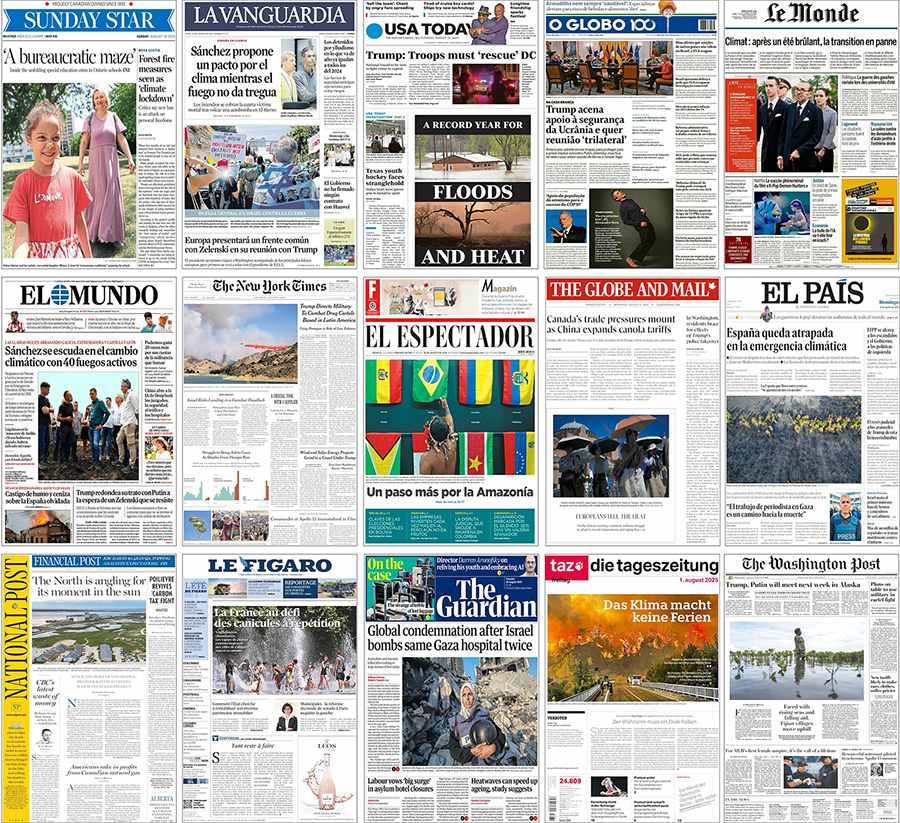
Figure 3. Examples of newspaper front pages with climate change stories in August 2025.
- report prepared by Max Boykoff, Rogelio Fernández-Reyes, Ami Nacu-Schmidt, Jeremiah Osborne-Gowey and Olivia Pearman

